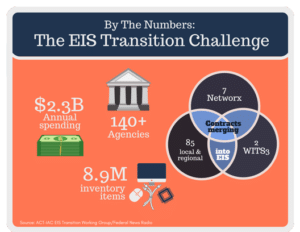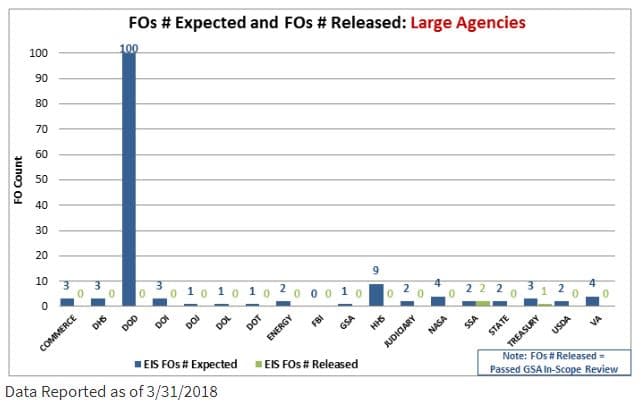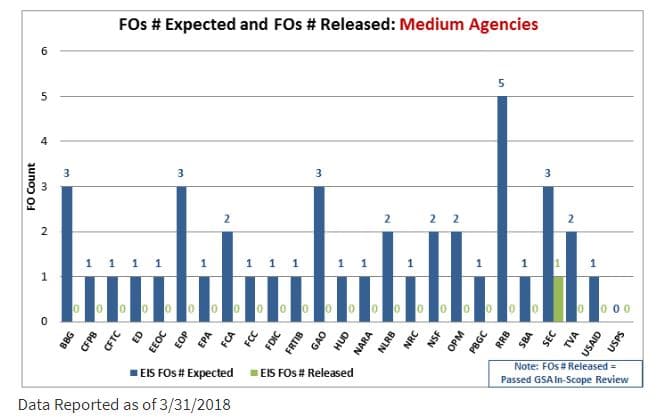

Crystal Philcox, GSA’s deputy assistant commissioner for IT Category in the Federal Acquisition Service, said GSA is confident that agencies will have time to...
Agencies have just under two years to move to the new governmentwide telecommunications contract called Enterprise Infrastructure Solutions.
 While this may seem like a lot of time, vendors and other industry experts are warning the General Services Administration that the current 11-year-old Networx contract may need to be extended.
While this may seem like a lot of time, vendors and other industry experts are warning the General Services Administration that the current 11-year-old Networx contract may need to be extended.
Crystal Philcox, GSA’s deputy assistant commissioner for IT Category in the Federal Acquisition Service, said GSA is confident that agencies will have time to transition to EIS and modernize their IT infrastructures at the same time.
“What’s not on the table right now is just extending current contracts, extending legacy capabilities and not modernizing, and then asking for an extension. I think that’s something we are not interested in,” Philcox said in an exclusive interview with Federal News Radio. “We are continuing to really listen to agencies and we have a lot of venues to do that. We have been working with them, talking with them, listening closely and I think for those agencies that are really trying to rethink, trying to modernize and move off those legacy systems, we are interested in hearing how much time that will take and what we can do to help with that.”
GSA awarded the $50 billion EIS contract to 10 vendors in August 2017 to replace the Networx contract, which GSA also awarded to 10 vendors in 2007.
But industry experts said given how long it will take for all the vendors to reach full operational capability, concerns about GSA’s timeline are growing across the community. And plenty of agencies and vendors remember the transition to Networx from FTS-2001, which was arduous and costly. The Government Accountability Office estimated agencies spent $395 million more and took 33 months longer than expected.
GSA, their agency customers and the contractors all agree that no one wants a repeat of the previous transition slog.
“My opinion three years ago when GSA identified May 2020 as the target transition date for completing the transition was it was a short amount of time. Some of the folks on the ACT-IAC community of interest got together and plotted out a tentative timeline and we recognized the transition would be tight back then,” said John Okay, an executive consultant at Topside Consulting, who retired after 30 years in government, where he was the deputy commissioner of GSA’s old Federal Technology Service during the FTS2001 transition effort. “Now that three-year transition is a two-year transition, and agencies have been slower than many of us would’ve liked to get their fair opportunity solicitations on the street. Altogether what was a very ambitious schedule is now, in my opinion, an impossible schedule. And that is without consideration of the new mandate from the administration to pursue IT modernization and implement the Modernizing Government Technology (MGT) Act.”
As of March 31, GSA said only the Social Security Administration and the Treasury Department had issued Fair Opportunity (FO) solicitations against EIS, while the Securities and Exchange Commission is the only medium size agency to release a FOs.

Topside’s Okay is among a growing chorus of industry experts that say it’s time for GSA to admit that their goal of a May 2020 transition is no longer realistic and they should begin to develop a plan B to provide assistance to agencies past that date.
Gary Wall, a former Networx program manager for the Department of Health and Human Services and now president of Coastal Communications Consulting Group, said agency transition plans developed more than a year ago didn’t include the emphasis the Trump administration has put on IT modernization through EIS.
“I think there are some competing priorities, especially with the introduction of IT modernization over past year. That has caused people to take step back and look at this through a different filter,” he said. “Now they are seeing largely the same schedule, but also additional changes with the sunsetting of GSA’s central billing system and the sunsetting of full regional services under Networx. Both of these are creating new challenges for agencies and if they also are looking at modernization, it adds another ripple in the schedule.”
Philcox said many agency transition plans are more than a year old, but several are going back for review and update. Additionally, the Office of Management and Budget has been working with several agencies to ensure the IT modernization emphasis is part of their strategies.
The concerns about the timeframe extend beyond consultants. CenturyLink executives briefed lawmakers in May about their concerns around the EIS transition timeline. CenturyLink is one of the incumbent contractors, holding both Networx and EIS contracts.
Meanwhile the interagency group made up of the 20 of largest agencies under the Networx contracts and led by the Justice and Defense departments senior executives, is expected to send GSA a letter expressing their concerns about the transition timeline. Industry sources say the letter will request more time beyond the May 2020 deadline.
Philcox said GSA meets regularly with the group to get an update on their modernization efforts, but as of the May 30 interview her office had not received a letter from the group for a request for extension.
“We had a great conversation just a few weeks ago about the contract transition issues, how many of them may need additional time and other conversations about if they would be able to take on and capture additional services during their initial solicitation or if they are building in ongoing modernization to their solicitation over time,” she said. “Over the next few weeks, we will be absorbing that information, reaching back out to a number of them and trying to put some things in place to really help and support them.”
She said if the interagency group submits a letter, GSA would take it under consideration and talk to them more about their modernization journeys.
Philcox said an extension to Networx, would require a host of reviews and approvals from agency leaders. But she said there is nothing in the contract itself or GSA acquisition regulations that would prohibit an extension from happening.

On the EIS website, GSA writes the Networx contracts have a 365-day continuity of service period that allows for services to continue to operate at the last year of contract pricing which would allow services to continue to March 2021.
“A continuity of service period is exercised on an already-expired contract. Once this period ends, there is no opportunity to extend the contract or services,” GSA writes.
Philcox said GSA recognizes the transition will not be easy and there still are a lot of unknowns at the agency level. At a recent industry day, almost 200 people from agencies showed up to learn more about EIS from the vendors about what is possible.
But while there is plenty of interest on both sides of the aisle—vendors and agency customers—actual implementation of services under EIS can’t begin until the contactor’s systems are approved and receive an authority to operate (ATO) under cybersecurity regulations.
Philcox said GSA expects all of the vendors to achieve the first goal of internal system approvals by November, and then will have to go through the cyber reviews.
This means, at best, agencies will not have the full complement of contractors to choose from until early 2019 and then have a year to begin implementing new services under EIS before Networx expires.
At the same time, agencies don’t have to wait until November or early 2019 to begin the Fair Opportunity process. Philcox said agencies can release their solicitations and go through the evaluation process, but just can’t award the contract until the vendor’s system reach full operational capability.
“We are encouraging folks to do release their Fair Opportunity solicitations early,” she said. “We know a lot of industry partners are concerned they will get a lot at one time, toward the end of the year. We are working with folks to get their solicitations out as soon as they can.”
Philcox said GSA offers a host of transition services, including funding, training and writing statements of work.
“My big concern is that vendors understand they need clear concise requirements and if they can do that, they can help the government be successful,” Wall said. “But there is a concern that the clarity is not a there yet because lost a lot of the previous transition experience either walked out the door or was handled by GSA. This will be the most complex one ever. There are 90-plus contracts moving to one vehicle when you add the WITS 3 and regional telecommunication contracts.”
Philcox said GSA encourages agencies to use managed services to help with the transition process and make up for not having enough in-house experience.
“We also are providing a system to them that they can use and leverage that will help them keep all of their orders organized, do their billing for them. We will be rolling that out in the future as they need to use it,” she said. “We are particularly concerned about smaller agencies who may not have the bandwidth to take something like this on. We will be really working with them to move to managed services. We are trying to pay close attention to who has those types of needs.”
Okay said nearly everyone recognizes GSA is, once again, in a tough position.
“They don’t control the timelines or budgets in agencies yet it’s their program and they have responsibility to help customers achieve an expeditious transition as possible,” he said. “I think agencies understand the financial and cyber benefits of moving as quickly as possible. And they are under severe budget pressure so they will do everything they can to reduce costs through EIS. At the same time, GSA or really OMB needs to add some clarity to the message around EIS, is it about transitioning away from Networx or is it about IT modernization?”
Copyright © 2025 Federal News Network. All rights reserved. This website is not intended for users located within the European Economic Area.
Jason Miller is executive editor of Federal News Network and directs news coverage on the people, policy and programs of the federal government.
Follow @jmillerWFED

